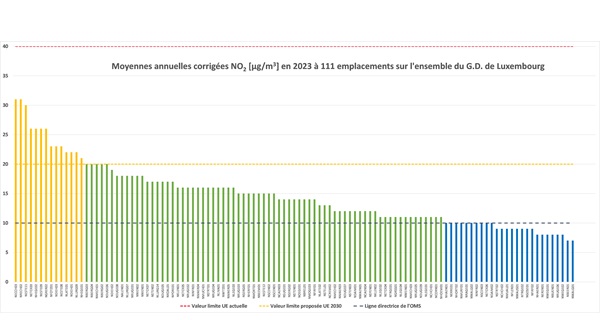 Annual averages of nitrogen dioxide (NO2) in 111 locations across the Grand Duchy;
Credit: Luxembourg's Environment Agency
Annual averages of nitrogen dioxide (NO2) in 111 locations across the Grand Duchy;
Credit: Luxembourg's Environment Agency
Luxembourg's Environment Agency announced it carried out the fifth national nitrogen dioxide (NO2) measurement campaign in 2023, in collaboration with the Klima-Agence and 33 Luxembourg municipalities, finding lower averages of the chemical compared to the previous year.
From 4 January to 20 December 2023, the pollutant was measured at 123 measuring points across the country. The limit value of 40 µg/m3 was not exceeded at any location and the annual NO2 averages even decreased compared to the previous year, the Environment Agency noted.
The annual averages of nitrogen dioxide (NO2) decreased compared to the previous year. All locations complied with the limit value of 40 µg/m³, set by the Air Quality Directive for the protection of human health. In addition, at the majority of locations, the future European limit value of 20 µg/m³, applicable from 2030, is reportedly already respected.
A notable peak of NO2 was observed in February, coinciding with an episode of fine particulate matter (PM10) pollution due to specific weather conditions such as dry, sunny weather and temperature inversions. Conversely, pollution levels decreased in July and August, a period corresponding to the summer holidays and a significant drop in road traffic.
In general, nitrogen dioxide (NO2) concentrations are higher during the winter months, mainly due to emissions from heating installations and unfavourable weather conditions. The winter of 2023, marked by abundant rainy periods, allowed a better dilution of pollutants, thus reducing the gaps between winter and summer concentrations, the Environment Agency explained.
Since 2018, a continuous decrease in annual averages of NO2 has been observed. According to the Environment Agency, this positive trend is explained by the modernisation of the vehicle fleet, the adoption of the new EURO standards and the increase in the number of electric vehicles, although the general increase in road traffic after the pandemic partially slowed down this decrease.
While the results are encouraging, it is nevertheless crucial to continue efforts to improve air quality, the Environment Agency stressed. The negotiations for a new European directive have resulted in the establishment of a new annual limit value for NO2 for 2030: the limit value will drop from 40 µg/m3 currently to 20 µg/m³ in 2030.
The Environment Agency added that it encourages urban municipalities that have not yet participated in these campaigns to join their efforts for a healthier environment.
The averages of all locations in 2023 are available on Geoportail; the full report can be downloaded from www.emwelt.lu.
The locations were chosen by the municipalities themselves. 33 municipalities participated with a total of 115 measuring points: Bettembourg, Contern, Dalheim, Diekirch, Differdange, Dudelange, Echternach, Erpeldange-sur-Sûre, Esch-sur-Alzette, Ettelbruck, Flaxweiler, Grevenmacher, Hesperange, Kopstal, Larochette, Leudelange, Mamer, Mersch, Mertert, Mondercange, Niederanven, Roeser, Rumelange, Schengen, Schieren, Schifflange, Schuttrange, Steinfort, Steinsel, Strassen, Waldbillig, Waldbredimus and Weiler-la-Tour. The Environment Agency noted it “welcomes” the first participations of the municipalities of Erpeldange-sur-Sûre and Flaxweiler.
The Environment Agency added eight additional locations in the territories of the cities of Luxembourg, Esch-sur-Alzette and Remich as well as in the territories of the municipalities of Wiltz and Beidweiler.
The City of Luxembourg operates its own measuring network. The measurement results of the Luxembourg City network can be consulted on www.vdl.lu/fr/la-ville/engagements-de-la-ville/actions-environnementales/preserver-la-qualite-de-lair.








